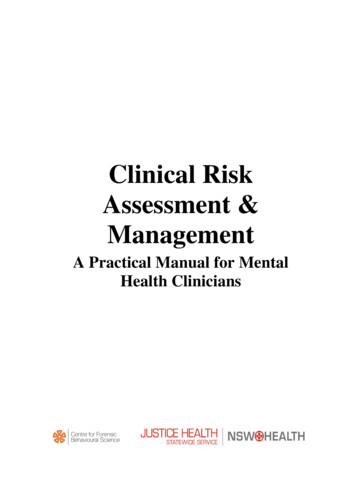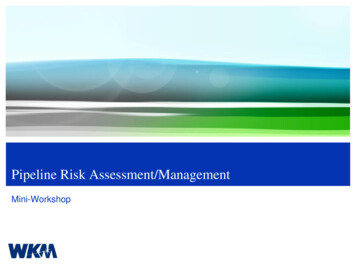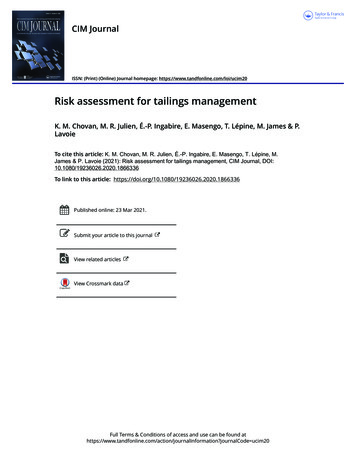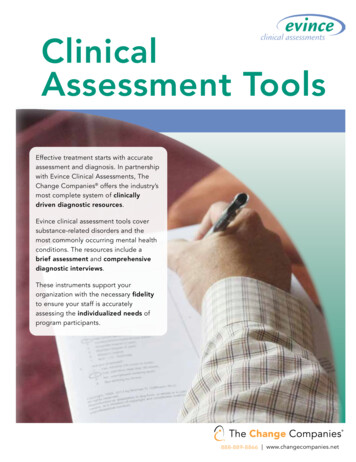
Transcription
Clinical RiskAssessment &ManagementA Practical Manual for MentalHealth Clinicians
DISCLAIMERThis handbook may be reproduced in whole or in part for study or trainingpurposes subject to the inclusion of an acknowledgement of the source. It may notbe reproduced for commercial use or sale. Reproduction for any means other thanstudy or training purposes requires written permission from Justice Health.Persons who violate professional ethical codes related to illegal and unfair use ofthese materials may be brought before relevant professional associations to whichthey belong.Justice Health accepts no responsibility or liability for errors or adverseconsequences arising from the use of information contained in this publication.This manual represents a revision of the Statewide Clinical Risk Assessment andManagement Training Program Participant Handbook first published in 2008.Further copies of Clinical Risk Assessment and Management. A Practical Manualfor Mental Health Clinicians can be downloaded from the Justice Health website:www.justicehealth.nsw.gov.auJustice Health1300 Anzac ParadeMalabar NSW 2036PO Box 150Matraville NSW 2036Phone: 61 2 9700 3000Fax: 61 2 9700 3493www.justicehealth.nsw.gov.au Justice Health 2010ISBN: 978-1-74187-562-1SHPN: (JH) 100179ReferenceAllnutt, S., O’Driscoll, C., Ogloff, J.R.P., Daffern, M. & Adams, J. (2010) ClinicalRisk Assessment & Management: A Practical Manual for Mental Health Clinicians.Sydney, NSW; Justice Health.i
AUTHORSStephen Hember AllnuttDr Allnutt trained in Psychiatry at McMaster University in Canada and in ForensicPsychiatry in Ottawa, Canada. During his career he has held a number ofpositions including Deputy Director of Mason Clinic (Auckland, NZ), and ClinicalDirector of Long Bay Hospital (Sydney, Australia). Dr Allnutt currently holds theposition of Clinical Director of the NSW Community Forensic Mental Health Serviceand held a ministerial appointment with the Sentinel Events-HomicideSubcommittee. Dr Allnutt is a conjoint Senior Lecturer at the University of NewSouth Wales. He is a well received speaker and has presented and publishedpapers both locally and internationally on forensic topics.Colmán O’DriscollMr Colmán O’Driscoll trained as a Psychiatric Nurse in St Patrick’s Hospital, Dublinstudying at the University of Dublin, Trinity College. He holds a Master of Nursingfrom the University of Western Sydney. In 2003 he moved to Sydney and startedworking in forensic mental health with Justice Health. He has wide rangingexperience in the NSW Forensic Mental Health system, including the provision ofcomprehensive psychiatric reports to NSW Local Courts. In 2009 Mr O’Driscollwas appointed Service Director, Statewide Forensic Mental Health, Justice Health.He is also a conjoint Lecturer with the School of Psychiatry, University of NewSouth Wales and teaches on the Masters of Forensic Mental Health Program. Hehas presented and published a number of papers on forensic topics.James R. P. Ogloff, JD, Ph.D., FAPSProfessor James Ogloff is trained as a lawyer and psychologist. He is a Fellow ofthe Canadian, American, and Australian psychological societies. He is theFoundation Professor of Clinical Forensic Psychology at Monash University andDirector of the Centre for Forensic Behavioural Science. He is also Director ofPsychological Services at the Victorian Institute of Forensic Mental Health(Forensicare). He has worked in clinical and forensic psychology in a variety ofsettings for more than 25 years. He has given invited addresses or workshops incountries around the world. Professor Ogloff is a leading researcher and clinicianin the area of violence risk assessment. He is the President of the Australian andNew Zealand Association of Psychiatry, Psychology and Law, past-Chair of theCollege of Forensic Psychologists of the Australian Psychological Society. He is aPast-President of the Canadian Psychological Association and a Past-President ofthe American Psychology-Law Society. Professor Ogloff has published 14 booksmore than 200 scholarly articles and book chapters. He is the recipient of the 2009Award for Distinguished Contributions in Forensic Psychology from the AustralianPsychological Society.ii
Michael DaffernDr Michael Daffern is a clinical and forensic psychologist. He has worked withinmainstream adult psychiatry, forensic mental health and correctional settings.Presently, he is Senior Lecturer with the Centre for Forensic Behavioural Scienceat Monash University, Principal Consultant Psychologist with the Victorian Instituteof Forensic Mental Health (Forensicare) and Special Lecturer with the Division ofPsychiatry at The University of Nottingham, UK. Dr Daffern’s research interestsfocus on the assessment and treatment of violent offenders, behaviouralassessment methods, risk assessment and management; personality disorder, andviolence within institutions.Jonathon AdamsDr Adams trained in general psychiatry in Birmingham, UK, achieved Membershipof the Royal College of Psychiatrists in 2005 and was elected to Fellowship of theRoyal Australian and New Zealand College of Psychiatrists in 2008. He completedadvanced training in forensic psychiatry with Justice Health, NSW, and wasawarded the RANZCP Advanced Training Certificate in Forensic Psychiatry in2009. Dr Adams is currently employed as a staff specialist forensic psychiatrist atThe Forensic Hospital, Justice Health, and also works in private practice. DrAdams has published research in areas of forensic psychiatry, has presented atpsychiatric conferences in Australia and the UK and is a Conjoint Lecturer,University of New South Wales.iii
ACKNOWLEDGEMENTIn preparation of the Clinical Risk Assessment & Management. A Practical Manualfor Mental Health Clinicians, we acknowledge and reference the New Zealand‘Assessment and Management of Risk to Others Trainee Workbook 2006’ and theStatewide Clinical Risk Assessment and Management Training ProgramParticipant Handbook.The authors would particularly like to acknowledge the work done by ProfessorChristopher Webster and colleagues in the development of the HCR-20.We acknowledge the contribution made by Dr David Chaplow, Director, MentalHealth in New Zealand along with Dr Sandy Simpson, Director of the RegionalPsychiatric Services in Auckland, New Zealand and their New Zealand colleagues.Also, many thanks to Mr Michael Davis, Mr Murray Ferguson, Mr Chi Meng Chu,Dr Andrew Carroll, Dr Daniel Riordan and Mrs Nicole Kitto.We would also like to thank our many colleagues within Justice Health, NSW andin particular the support of Ms Julie Babineau, Chief Executive, Professor KarinLines and Associate Professor John Basson.“We are not now and probably never will be in a position to be able to determinewith certainty who will or will not engage in a violent act. Relying on a range ofempirically supported risk factors, though, we can make a reasoned determinationof the extent to which those we are assessing share the factors that have beenfound in others to relate to an increased level of risk.” Mullen & Ogloff1iv
PREFACE"Risk: The nature, severity, imminence, frequency/duration and likelihood ofharm to self or others. A hazard that is to be identified measured and ultimately,prevented". (Best Practice in Managing Risk, document prepared for the NationalMental Health Risk Management Programme. June 2007).This definition comes from a document “Principles and evidence for best practicein the assessment and management of risk to self and others in mental healthservices. This was produced in the United Kingdom in 2007.In New South Wales, as in other states and countries with modern psychiatricservices, we are being asked about the risk that mentally ill people present tothemselves, their family members and other members of the public.We know that there is a real increased risk of serious harm to others by thementally ill, though it is small. The advent of increased use of illicit drugs has madethis a much more real issue.Assessing the risk, formulating a management plan, and carrying it into action willimprove patient care and from that position it will have a possible impact on futureharm.How is this assessment done? We know that most mental health clinician’sprediction of risky incidents by their patients is just above the level of chance. Whatwe are endeavoring to do is improve risk assessment and management. Severalactions are important:-Collecting as much information as is possible and analyzing it regardingfrequency, circumstances, severity of the risky behaviour.Speaking with family, friends, staff caring for the patient.Using actuarial tools that indicate the level of risk of the group which thepatient belongs.Putting all the information collected together and systematically examine itto assess the risk.Formulate a management plan.All of this should be done with careful, involvement of the patient, carers andstaff of mental health services.In saying all of this we must be clear that the responsibility for risk management isnot just the responsibility of individual practitioners. In the document from theDepartment of Health in London referred to at the start of this preface there is areference to their National Patient Safety agency and seven steps to patient safety.v
These are: Build a safety cultureLead and support your staffIntegrate your risk management activityPromote reportingInvolve and communicate with service users and the publicLearn from and share safety lessons, andImplement solutions to prevent harmRisk management is every member of staffs’ responsibility and all clinicians needto agree the strategy and method they will use to assess and manage clinical risk.This will need regular review and modification in the light of experience.It is important therefore to train staff in risk assessment and risk management.The manual that follows and the work done along with it is one such training. Weare grateful to colleagues in New Zealand, particularly for the work they have donein this area of mental health service development as we borrowed from them andwere encouraged. The work from the United Kingdom – England and Scotland hasalso encouraged us in our endeavour.In all of this work there is a need for the patient to be fully involved and the roleplayed by carers and staff respected. Culture and background are vital aspects ofour identities that must be taken into account. The emphasis of our New Zealandcolleagues on Maori culture reminds us that our Aboriginal patients have importantcultural beliefs which need to be integrated in any plan. Patients from a culturallyand linguistically diverse background equally need extra attention. Such mattersare part of our identity, sense of self so often challenged by mental illnessinstitution services.Leadership in all these matters is crucial and this training is to give practitioners theskills required for the task.A/Professor John BassonStatewide Clinical DirectorForensic Mental Healthvi
CONTENTSDISCLAIMER . iAUTHORS . iiACKNOWLEDGEMENT . ivPREFACE. vCONTENTS . viiFOREWORD. ix1INTRODUCTION .11.1Cultural Diversity .21.2Mental Health Legislation.21.3Forensic Patients.21.4Considering Base Rates .32MENTAL ILLNESS & VIOLENCE.52.1The Relationship between Mental Illness and Violence .62.1.1The Australian Context .82.2Psychiatric Hospitals: A Unique Context .92.2.1The Relationship between Mental Illness and Violence in Psychiatric Hospitals .93BACKGROUND TO RISK ASSESSMENT . 113.1The Nature of Risk. 113.2The Nature of Violence . 123.3The Issue of Malingering. 133.4Antisocial Personality Disorder (ASPD) & Psychopathy. 143.5Approaches to Risk Assessment. 153.5.1Unstructured Clinical Judgement . 163.5.2Actuarial Approach . 173.5.3Structured Professional Judgement . 183.5.3.1Anamestic Assessment . 193.6False Positives, False Negatives and the Problem of Errors. 194THE PROCESS OF RISK ASSESSMENT . 214.1Risk Factors . 224.2Violence in the Community (Short to Medium Term). 234.2.1Static Risk Factors (Past) . 234.2.2Dynamic Risk Factors (Present) . 244.2.2.1Internal Risk Factors . 244.2.2.2External Risk Factors . 254.2.3Case Specific Risk Factors . 254.2.4Protective Factors . 254.3Violence in the Inpatient Setting. 264.3.1Static Risk Factors. 264.3.2Dynamic Risk Factors. 264.3.3Patient Factors . 264.3.4Staff Factors. 274.4The Relationship between Static and Dynamic Factors . 274.5Clinical Contexts. 305CRAM FRAMEWORK. 315.1Principles of Assessment. 315.1.1Clinical Interview . 315.1.2Documentation Review. 335.1.3Collateral Information . 335.1.4Identifying Risk Factors . 335.1.5Anamnestic Assessment . 345.1.6Further information required . 345.2Principles of Formulation . 345.2.1Static – Dynamic Ratio . 355.2.2Anamnestic Summary. 355.2.3Identification of Early Warning Signs. 35vii
5.3Principles of Management . 355.3.1Developing a Plan . 365.3.2Treatment. 375.3.3Placement . 375.3.4Restrictions . 385.3.5Implementation. 385.3.6Monitoring . 395.4Principles of Review . 396RISK ASSESSMENT AND MANAGEMENT - THE INPATIENT SETTING. 416.1Step 1 – Assess. 436.2Step 2 – Formulate . 446.3Step 3 – Management . 446.4Step 4 - Review . 466.4.1The Shorter Term . 466.4.2The Longer Term. 476.4.3Discharge Planning . 487RISK ASSESSMENT AND MANAGEMENT - THE COMMUNITY SETTING . 497.1Step 1 – Assess. 497.2Step 2 – Formulate .
studying at the University of Dublin, Trinity College. He holds a Master of Nursing from the University of Western Sydney. In 2003 he moved to Sydney and started working in forensic mental health with Justice Health. He has wide











